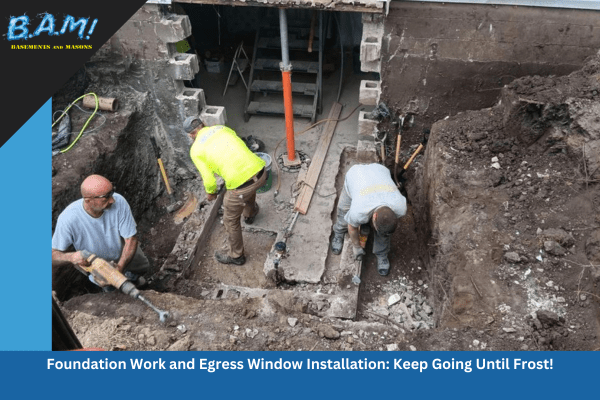Best Basement Waterproofing Things To Know Before You Get This
Best Basement Waterproofing Things To Know Before You Get This
Blog Article
Not known Factual Statements About Best Basement Waterproofing
Table of Contents10 Simple Techniques For Best Basement WaterproofingThe Greatest Guide To Best Basement WaterproofingSome Known Factual Statements About Best Basement Waterproofing Getting My Best Basement Waterproofing To WorkNot known Details About Best Basement Waterproofing
What causes water damage issues in your cellar? Pipelines that line the within of your wall surfaces are simply one example of where water damage can take place.The soil and ground of your home is really crucial. If there is way too much water bordering your home, nevertheless, it can push the soil right into your home and cause the seals of your basement to become endangered. Best Basement Waterproofing. when you see excess water in areas where it must not be, that is an excellent indicator that you have a problem
Concrete waterproofing layers are cement-like; once completely dry, they stick completely to concrete and stonework walls. You apply the coating with a heavy brush made with bristles swirled throughout application for an appealing, completed appearance. Nevertheless, concrete water resistant layers can not be put on formerly repainted surfaces Silicate-based concrete sealers, additionally understood as densifiers, are additionally ideal only for wall surfaces that have not been repainted or secured.
Due to the fact that these are permeating sealants, they can't exfoliate or peel off, and you can have paint applied over them. The American Eagle team might discover a lot more challenging reasons for your dampness problems; there are added solutions readily available. Plastic sheets and panels could be combined with indoor cellar drain systems. They don't quit water from surviving the wall, yet they do stop it from spoiling things in the basement.
Some Ideas on Best Basement Waterproofing You Should Know
A sump pump is needed to relocate water out of your cellar. Below are a few things the specialists can mount to assist the waterproofing process: this is designed for the walls of your cellar.
It also assists stop the growth of mold or mold, which can be a pretty huge carcinogen. Cellar waterproofing is a fantastic way to be successful of possible water damages that might come your way. Do not hesitate to speak to local specialists, like those at American Eagle with any type of waterproofing questions you may have concerning what basement waterproofing looks like and extra.
Rumored Buzz on Best Basement Waterproofing
When it concerns securing your home, among one of the most important actions you can take is cellar waterproofing. A dry basement not just ensures a risk-free and healthy atmosphere for you and your family, yet it additionally assists to avoid costly water damages and mold and mildew growth. In this blog site message, we will certainly review the relevance of cellar waterproofing, the advantages it gives, and just how you can deal with safeguarding your area.
By buying cellar waterproofing now, you can help to make sure that your home preserves its value and beauty with click here to find out more time. An additional advantage of basement waterproofing is that it can assist to reduce your power expenses. A damp basement can contribute to greater levels of humidity in your house, which can make your heating and cooling system job more challenging to preserve a comfy temperature.
When it concerns cellar waterproofing, there are several methods that can be made use of to keep water out of your area. These include indoor sealants, try this outside waterproofing membranes, and drainage systems. The most effective method for your cellar will depend upon variables such as the level of water intrusion, the condition of your foundation, and your budget plan.
Finally, basement waterproofing is a vital action in shielding your home from water damage, mold and mildew growth, and other issues. By purchasing basement waterproofing, you can guarantee that your area stays dry, risk-free, and healthy and balanced for you and your family. Not just does basement waterproofing supply comfort and protection for your home, but it can additionally enhance its value and save you money on energy costs over time.
The Buzz on Best Basement Waterproofing
Inside sealers are a kind of cellar waterproofing method that entails using a sealant to the within the basement wall surfaces and floors. Water can permeate right into a cellar via cracks, voids, or porous concrete, specifically in areas where there is high groundwater or poor water drainage. This can lead to water damage and mold development, as well as damages to the structure and architectural honesty of the structure.
The sealant creates an obstacle that protects against water from leaking with the concrete. Nonetheless, this method is only efficient for small water damages and does not resolve the underlying root causes of the wetness. The main resource straight from the source of the need for exterior cellar waterproofing is water infiltration from the beyond the foundation wall surfaces.
It is an effective remedy for protecting against water damages and maintaining the architectural stability of the building. It can be pricey and disruptive to mount, as it calls for excavation around the foundation and might involve landscaping and other repair work once the waterproofing is full. However, this method is one of the most trusted and long-lasting option for preventing water seepage in the basement.
8 Simple Techniques For Best Basement Waterproofing

Report this page